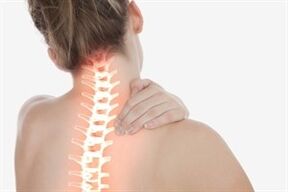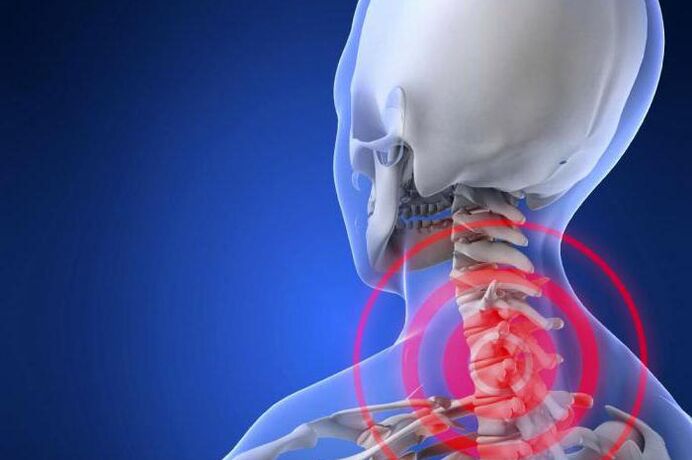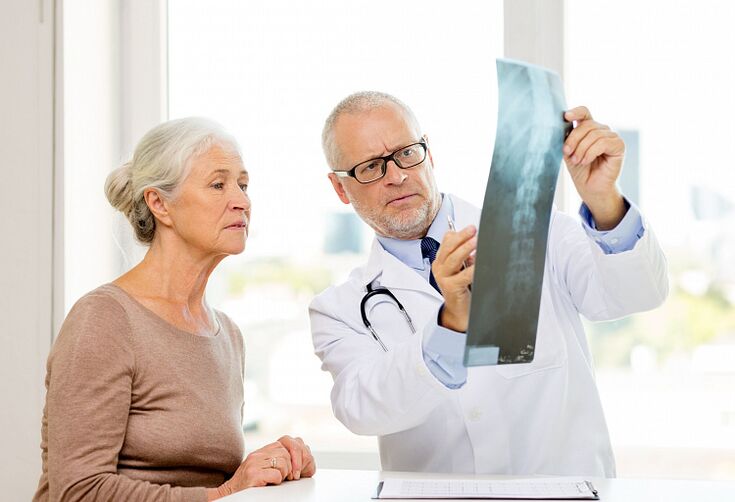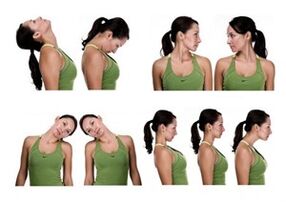
Cervical osteochondrosis is a dystrophic dysfunction of the intervertebral discs in the cervical spine. The disease manifests itself in the form of severe pain in the head, neck and upper back.
The danger of osteochondrosis lies not only in the deterioration of quality of life, but also in the risk of disability.
Features of the SOC course in women
The symptoms of developing spinal diseases in men and women are practically the same, but there are still some differences. In women, cervical osteochondrosis is diagnosed more often. This is due to the anatomical features.
Unlike women, men have well-developed shoulder girdle muscles, which support the cervical spine.
Reference.The condition of the spine is adversely affected by pregnancy and the subsequent period of child care.
The reason for the development of female cervical osteochondrosis could be the hormonal changes that occur during the aging process. After menopause, there is a slowdown in metabolic and nutritional processes in cartilage tissue.
Causes and factors
There are many reasons for the development of SOS in women. The most common are menopausal changes in the body. During this period, the amount of progesterone in the female body decreases significantly. As a result of these processes, the support of the column becomes weaker.Other reasons include the following factors:
- circulatory problems;
- passive lifestyle;
- the presence of excess weight;
- great physical activity;
- weak immunity;
- heredity;
- spinal injury;
- hormonal problems;
- hypothermia.
The list of provoking factors is quite extensive. Women need to take special care to monitor their health and support their immune system.
Symptoms
How the disease manifests itself at an early stage

It is important to recognize the signs of disease development in a timely manner.Early symptoms include:
- feeling of stiffness in the neck;
- sudden onset of snoring during sleep;
- frequent headaches;
- finger and shoulder discomfort;
- periodic dormancy of limbs;
- shooting pains that radiate to the neck.
local signs
With cervical osteochondrosis, several local symptoms occur.These include the following manifestations:
- stenosis;
- reflex-irritative syndrome;
- radicular syndrome;
- heart syndrome.
Stenosis involves a violation of blood circulation in the affected area. The patient feels stiffness and pain. There may be numbness and tingling in the extremities.
The irritative reflex syndrome can manifest itself in the form of a burning and tingling sensation. The pain may radiate to the shoulder or chest joint.
Root syndrome causes headaches. Sometimes there are problems with speech.
Cardiac syndrome, by its nature, resembles an attack of angina pectoris. In some cases, blood pressure rises and arrhythmia appears.
Signs of an acute condition
During the acute phase, deformations of the vertebrae are observed, which compress the vertebral artery.Due to the fact that blood does not enter the brain, the following deviations are observed:
- speech disorder;
- dizziness;
- buzz;
- double vision.
The pain can radiate to the stomach, heart and lungs. When the nerve endings in the cervical region are compressed, there is pain pulling from the neck to the shoulder blades.
Stages of the disease and their distinctive features
SHOC proceeds in several steps. Each of them has its own distinct symptoms.In total, there are 4 main stages in the development of osteochondrosis:
- In the early stage, the disease resembles dehydration of the nucleus pulposus. The patient develops fissures in the annulus fibrosus.
- The second phase involves the sagging of muscles and ligaments. As a result, there is a motor imbalance of the vertebrae. This stage of the development of the disease is characterized by displacement of the vertebrae.
- The third stage of development is characterized by more pronounced symptoms. Patients develop intervertebral disc bulges and osteoarthritis.
- The fourth step is the last. A distinctive feature is osteophytes. Bone growths form on the surface of the vertebrae. There is an increase in fibrous tissue.
In the absence of timely diagnosis and treatment, the disease can lead to disability.
Diagnosis
If the first symptoms of the disease occur, you should consult a doctor for an examination and prescribe the appropriate treatment.In addition to taking a history, the doctor prescribes a series of diagnostic studies.
Instrumental examination methods
Instrumental diagnostic methods will help to accurately diagnose and determine the patient's condition. The most commonly prescribed procedures are:

- X-ray;
- myelographic study;
- ultrasound;
- MRI.
Plain radiography is needed to obtain an image of the entire spine or the affected part.With its help, the doctor will be able to establish the location of the pathology. With osteochondrosis on the spine image, you can see the presence of bone growths and narrowing of the intervertebral disc.
A more complex type of diagnosis is a myelographic study. It consists of the fact that a contrast fluid is injected into the spinal cord canal.
Important.Such a procedure can be dangerous as an allergic reaction or damage to the spinal cord is possible.
Such a study allows you to study the internal structure of the spinal canal.
CT and MRI are among the most effective diagnostic methods. According to their results, osteochondrosis can be distinguished from other diseases with similar symptoms.
Treatment
medical therapy
Treatment of cervical osteochondrosis must be comprehensive. An important part is drug therapy.In most cases, the following groups of drugs are prescribed:
- analgesics;
- anti-inflammatory;
- chondroprotectors;
- muscle relaxants;
- vitamins.
Pain relievers include non-steroidal drugs that relieve pain. Most of these drugs are irritating to the lining of the digestive tract.
To relieve the inflammatory process, hormonal drugs are prescribed.Effective steroid medications include glucocorticosteroid-based ointments and tablets.
Chondroprotectors contain in their composition substances that replace the components of cartilaginous tissue - hyaluronic acid and chondroitin. In order to obtain a lasting effect when taking these drugs, a rather long therapeutic course is prescribed.
To relax muscle tone, it is recommended to take muscle relaxants.These are auxiliary medications for pain relief. The muscle relaxant is administered parenterally and only under specialist supervision. For the treatment of osteochondrosis, agents based on benzimidazole and glycerin are used. They have a large number of contraindications.
To maintain the functioning of the immune system, vitamin complexes are prescribed. They have a positive effect on the peripheral nervous system. The composition must contain fat-soluble vitamins E, D, C, E and vitamins B.
Quite effective in the treatment of osteochondrosis ointments for external use.They help relieve inflammation, warm up and relieve pain. Before using them, you should consult a specialist.
Are the drugs effective?
Drug treatment for cervical osteochondrosis is quite effective. It allows you to get rid of the inflammatory process and relieves pain. To get the maximum therapeutic effect, medication intake should be combined with therapeutic exercise and massage.
Fitness
Before starting gymnastics, you should consult a specialist. During exacerbations, it is better to refuse physical activity. It is important that gymnastics does not cause an exacerbation of pain.
Reference.All exercises are as simple as possible and involve head movement and isometric muscle tension.
This gymnastics can be performed both at home and at work. The starting position for almost all exercises is a sitting posture. Approximate set of exercises:
Approximate set of exercises:
- The head turns all the way to the right, then to the left. It is important not to push hard. When turning, the tension must be maintained for 5 seconds.
- Tilt your head to your shoulder. You need to try to touch your shoulder with your ear, while not lifting your hand. The exercise should be done with painless amplitude.
- Circular movements of the head against and clockwise. Rotations should be performed as slowly as possible.
Such a light load will help stretch the muscles. In order to bring good results, this gymnastics must be performed regularly. In this case, the increase in load should be gradual and painless.
Massage
Massage should only be performed by a professional. It is necessary to work the cervical region, part of the back and the collar area.The following techniques can be applied:
- caressing;
- squeeze;
- crushing;
- crumple.
Massage should not be painful. A procedure performed by non-professionals can only worsen the situation.
Folk remedies at home
Alternative methods of therapy may be used in addition.It can be compress of fresh horseradish leaves. They are applied to the cervical region and must be kept overnight.
Quite effective compress of grated potatoes and honey. This procedure should be carried out no more than once a week. Folk remedies will help alleviate the patient's condition, but they will not cure the disease.
Is it possible to completely cure SHX?
Cervical osteochondrosis cannot be completely cured.The therapy aims to improve the patient's condition and stop the development of the disease. Periodic relapses are possible, so the patient should carefully monitor their condition. The sooner treatment is started, the better the result.
Prevention
proper nutrition

An important place in the prevention of cervical osteochondrosis is proper nutrition. The diet should contain products that contain substances synthesized for cartilage tissue. It can be gelatin, gelatin or gelatin.
Important.The body must have enough protein.
It is found in fish, eggplant and meat. It is important to monitor the water balance. Lack of water can lead to dehydration of the intervertebral discs.
The diet should include foods rich in vitamins and minerals. For example, fresh fruits, vegetables, seafood, pork and beef.
active lifestyle
An active lifestyle will minimize the risk of developing the disease.Women are not recommended to lift more than 10 kg. In case of problems with the spine, it is recommended to use a special corset.
To have a quality and long sleep, it is better to buy a special orthopedic mattress and pillow. Experts recommend swimming, but it is better to refuse to run and jump. During the period of exacerbation, you cannot visit the bath.
Cervical osteochondrosis is most often diagnosed in women.It is important to notice the first signs of deviation in time and start treatment. The sooner therapy is started, the more effective it will be.


























